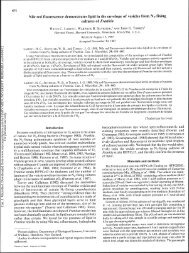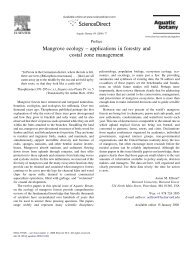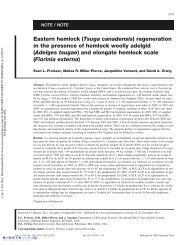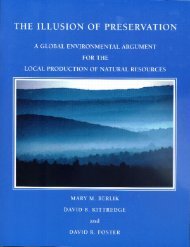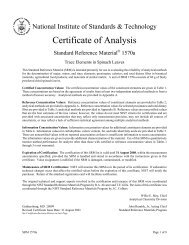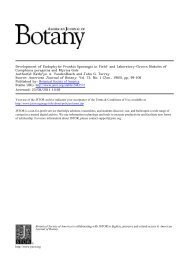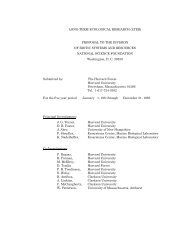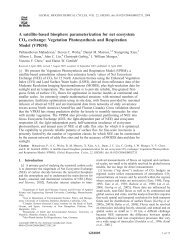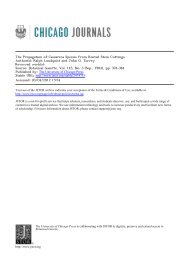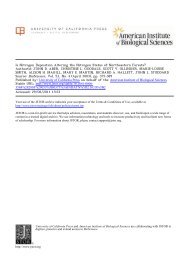Abstracts of Papers - Harvard Forest - Harvard University
Abstracts of Papers - Harvard Forest - Harvard University
Abstracts of Papers - Harvard Forest - Harvard University
Create successful ePaper yourself
Turn your PDF publications into a flip-book with our unique Google optimized e-Paper software.
Tsuga canadensis, which may be a reflection <strong>of</strong> .the<br />
stronger apical dominance in the former species. The<br />
pipe model would have to be modified to account for<br />
the above data, such that each unit pipe system had<br />
many more but smaller tracheids near the top than the<br />
bottom <strong>of</strong> the tree, and such that the trunk component<br />
<strong>of</strong> a unit pipe had more and wider tracheids than the<br />
lateral branch component. A more useful morphogenetic<br />
model involves hormonal gradients that control tracheid<br />
size and number in the plant. Hydraulically the ar-<br />
chitecture <strong>of</strong> these species favors the trunk over<br />
lateral branches and may thus help the upper leaves on<br />
the tree to compete with lower leaves for water and<br />
minerals.<br />
FAGERBERG, WAYNE, R. Dept. <strong>of</strong> Biology,<br />
Southern Methodist <strong>University</strong>, Dallas, TX<br />
75275.- A morphometric analysis <strong>of</strong> the<br />
homogeneity <strong>of</strong> palisade cell structure in<br />
leaves <strong>of</strong> Helianthus annuus. L.<br />
Leaves were divided into four quadrants and<br />
random samples taken from each quadrant.<br />
The ratio descriptors, Vv and Sv were cal-<br />
culated to describe the relationship between<br />
organelle compartment and cell size for the<br />
chloroplast, mitochondria, vacuole, micro-<br />
body, oil, starch, and mitochondrial -<br />
chloroplast membrane compartments. Since<br />
ratio values do not <strong>of</strong>ten reflect changes<br />
in mean cell volume, cell volumes and actual<br />
compartment sizes were also determined. In<br />
mature fully expanded leaves statistically<br />
significant variations were found between<br />
quadrants in Vv ratio <strong>of</strong> the chloroplast,<br />
vacuolar and starch compartments and in the<br />
Sv ratios <strong>of</strong> the granal membranes. The<br />
granal membrane compartment was the most<br />
variable, between sampled quadrants. The<br />
starch compartment was significantly smaller<br />
in the bottom 1/2 <strong>of</strong> the leaf suggesting<br />
that starch may be more rapidly mobilized<br />
from the lower half <strong>of</strong> the leaf. This study<br />
suggests that palisade cells are not homo-<br />
genous throughout the whole leaf due to<br />
variation in organelle compartments involved<br />
with photosynthesis. These results will be<br />
compared to similar data derived from<br />
developing leaves.<br />
FIORES, EUGENIA M. Escuela de Biologia, Univer-<br />
sidad de Costa Rica, San Josg, Costa Rica, Amgrica<br />
Central. - Cauline glands <strong>of</strong> Gunnera insignis.<br />
Cauline glands <strong>of</strong> Gunnera insignis were studied with<br />
light and scanning electron microscopy. Two types<br />
are recognized: (1) stellate glandular trichomes<br />
secreting mucous material and (2) whitish lobulated<br />
bodies covered by stomata which release water. The<br />
glandular trichomes develop around the leaf<br />
primordia and between the numerous squamules. These<br />
organs, as well as the shoot apex, are immersed in<br />
the mucous secretion. Many filaments <strong>of</strong> Nostoc and<br />
other organisms (algae, fungi, nematodes, insect<br />
larvae) are observed living in the mucilage. Nostoc<br />
is also recognized inside the trichomes and cauline<br />
tissues. Eventually, these trichormes degenerate and<br />
form brownish spots associated with Nostoc. The<br />
structures wich release water develop later and<br />
occupy the spaces left by the glandular trichomes.<br />
They cease functioning, turn green and extend<br />
longitudinally when the leaf~ which they surround<br />
Developmental and Structural Section 21<br />
reaches maturity. The interaction Gunnera - Nostoc<br />
represents the only known symbiosis between an<br />
angiosperm and a nitrogen-fixing bluegreen alga.<br />
This relationship is still not well known.<br />
Apparently in Gunnera the alga Nostoc penetrates<br />
through the glandular trichomes. It seems pertinent<br />
to study the role <strong>of</strong> these glands in relation with<br />
Nostoc penetration and the nitrogen fixing mechanism.<br />
FOLSOM, MICHAEL W. Dept <strong>of</strong> Botany, Univ. <strong>of</strong> Alberta,<br />
Edmonton, Alberta, CANADA T6G 2E9. -Structural aspects <strong>of</strong> the<br />
central cell gf Soybean. Glycine max (L) Merr. with respect to<br />
fixation technique.<br />
Ultrastructure <strong>of</strong> the eight nucleate embryo sac <strong>of</strong> soybean Glycine<br />
max (L.) Merr. demonstrates an unusual sequence <strong>of</strong> events in the<br />
central cell. Metabolites enter the embryo sac, are polymerized into<br />
starch grains, and are degraded mostly disdppearing from the<br />
central cell before fertilization. These starch grains are organized<br />
into groups that have been referred to as "packets" by previous<br />
workers. Unlike starch grains reported in most plant cells these<br />
packets do not appear to be membrane bound. The absence <strong>of</strong> a<br />
membrane is most likely not caused by fixation problems since<br />
other membrane bound organelles <strong>of</strong> the central cell exhibit normal<br />
membranes. The addition <strong>of</strong> Alcian Blue 8GX (AB) to the fixation<br />
process shows that rather than being naked or bound by a plastid<br />
membrane, these paskets are at least partially enclosed in a layer <strong>of</strong><br />
amorphous material, a mucopolysaccharide, deposited some time<br />
after the starch grains begin to form. Coomassie Brilliant Blue has<br />
shown that the material surrounding the starch packets has a protein<br />
component. The role <strong>of</strong> Alcian Blue acting as stabilizing agent for<br />
this glycoprotein and the preservation <strong>of</strong> cellular components by<br />
various fixation techniques (e.g. GA/Os04, GA + AB/Os04,<br />
GA/OsOi/TA/OsO4, and freeze substitution) will be discussed with<br />
respect to the starch packets and associated glycoprotein in the<br />
central cell.<br />
FREEMAN, THOMAS P., MURRAY E. DUYSEN AND<br />
THOMAS J. GULYA. Departments <strong>of</strong> Botany and<br />
Plant Pathology, North Dakota State<br />
<strong>University</strong> and U.S.D.A. Agricultural<br />
Research Service, Fargo, N.D. 58105.<br />
chloroplasts caused by Pseudomonas<br />
syringae pv. ta etis.<br />
Severe chlorosis and ultrastructural modifi-<br />
cations <strong>of</strong> chloroplasts occur in sunflowers<br />
in response to infections <strong>of</strong> Pseudomonas<br />
syringae pv. tagetis. Chlorosis became<br />
apparent within two days after the cotyledons<br />
<strong>of</strong> ten day old sunflower seedlings were<br />
inoculated with the bacteria. The first<br />
symptoms gererally appeared in the center <strong>of</strong><br />
leaves at the second node above the cotyle-<br />
dons. During the rext few days the chlorosis<br />
progressed to include leaves at several<br />
nodes. Despite the fact that some <strong>of</strong> these<br />
leaves lost essentially alL <strong>of</strong> their pigmen-<br />
tation they remained turgid and continued to<br />
expand. The loss <strong>of</strong> pigmentation is<br />
directly related to ultrastructural changes<br />
within the chloroplast. Grana thylakoids<br />
became dilated and separated from the granal<br />
stacks. These thylakoid membranes were not<br />
altered as in the cases <strong>of</strong> chromoplast<br />
formation or normal senescence. Both grana<br />
and stroms thylakoid membranes coalesced to<br />
form a large membrane sheet in the center <strong>of</strong><br />
the plastid. Starch and plastid ribosomes<br />
were lost early in the chlorotic cycle.<br />
Other cellular organelles do not appear to be<br />
altered by the bacterial i nf ection .




